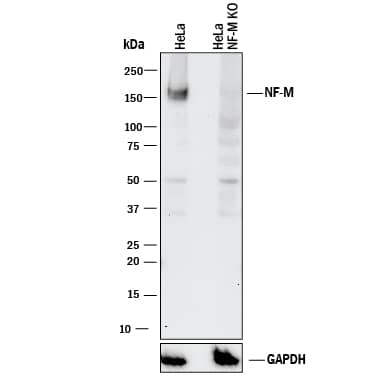Human NF-M Antibody
R&D Systems, part of Bio-Techne | Catalog # MAB3029

Key Product Details
Validated by
Knockout/Knockdown
Species Reactivity
Human
Applications
Knockout Validated, Western Blot
Label
Unconjugated
Antibody Source
Monoclonal Mouse IgG1 Clone # 327921
Product Specifications
Immunogen
E. coli-derived recombinant human NF-M
Ser2-Ser358
Accession # P07197
Ser2-Ser358
Accession # P07197
Specificity
Detects human NF-M in direct ELISAs and Western blots. In direct ELISAs and Western blots, no cross-reactivity with recombinant human (rh) NF-H or rhNF-L is observed.
Clonality
Monoclonal
Host
Mouse
Isotype
IgG1
Scientific Data Images for Human NF-M Antibody
Western Blot Shows Human NF‑M Specificity by Using Knockout Cell Line.
Western blot shows lysates of HeLa human cervical epithelial carcinoma parental cell line and NF-M knockout HeLa cell line (KO). PVDF membrane was probed with 2 µg/mL of Mouse Anti-Human NF-M Monoclonal Antibody (Catalog # MAB3029) followed by HRP-conjugated Anti-Mouse IgG Secondary Antibody (Catalog # HAF018). A specific band was detected for NF-M at approximately 155 kDa (as indicated) in the parental HeLa cell line, but is not detectable in knockout HeLa cell line. GAPDH (Catalog # MAB5718) is shown as a loading control. This experiment was conducted under reducing conditions and using Immunoblot Buffer Group 1.Applications for Human NF-M Antibody
Application
Recommended Usage
Knockout Validated
NF‑M
is specifically detected in HeLa human cervical epithelial carcinoma parental cell line but is not detectable in
NF‑M knockout HeLa cell line.
Western Blot
NF‑M is specifically detected in HeLa human cervical epithelial carcinoma parental cell line but is not detectable in NF‑M knockout HeLa cell line.
Formulation, Preparation, and Storage
Purification
Protein A or G purified from hybridoma culture supernatant
Reconstitution
Reconstitute at 0.5 mg/mL in sterile PBS. For liquid material, refer to CoA for concentration.
Formulation
Lyophilized from a 0.2 μm filtered solution in PBS with Trehalose. *Small pack size (SP) is supplied either lyophilized or as a 0.2 µm filtered solution in PBS.
Shipping
Lyophilized product is shipped at ambient temperature. Liquid small pack size (-SP) is shipped with polar packs. Upon receipt, store immediately at the temperature recommended below.
Stability & Storage
Use a manual defrost freezer and avoid repeated freeze-thaw cycles.
- 12 months from date of receipt, -20 to -70 °C as supplied.
- 1 month, 2 to 8 °C under sterile conditions after reconstitution.
- 6 months, -20 to -70 °C under sterile conditions after reconstitution.
Background: NF-M
Long Name
Neurofilament Protein, Medium Chain
Alternate Names
NEF3, NEFM, NFM
Entrez Gene IDs
4741 (Human)
Gene Symbol
NEFM
UniProt
Additional NF-M Products
Product Documents for Human NF-M Antibody
Product Specific Notices for Human NF-M Antibody
For research use only
